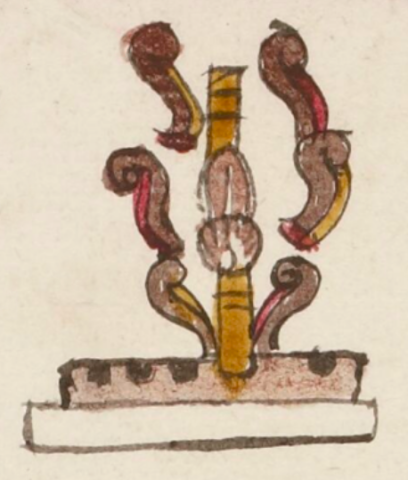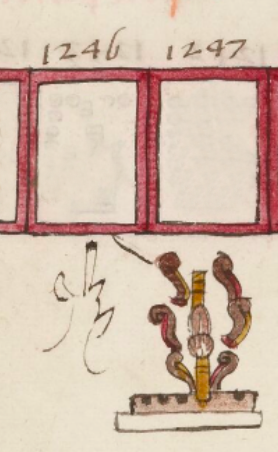mamalhuaztli (TR27r)
This simplex glyph for fire drilling (mamalhuaztli) comes from the Codex Telleriano-Remensis. It compares somewhat favorably to the examples from the Codex Mendoza (see below), although the colors vary. This one shows a segmented arrow (possibly made from a cane called carrizo in Spanish) with fletching being employed for the drilling. Curls of smoke rise up from the hot spot where the arrow meets the horizontal piece of wood. This one has a flat, white, horizontal foundation upon which the piece of wood sits.
Stephanie Wood
The New Fire Ceremony was called the xiuhmolpilli, when 52 years were "bundled," so this drilling of the fire was related to the calendar. The gloss (and the line from the horizontal calendar to the glyph) shows that this particular fire drilling took place in the year 1246. See this image of a fire-drilling ceremony in the Codex Borbónicus. See also the short article about the fire drilling ceremony in Mexicolore.
Stephanie Wood
1246
ca. 1550–1563
Jeff Haskett-Wood and Stephanie Wood
fires, fuegos, incendios, flechas, plumas, calendarios, xiuhpohualli, año, turquesa, xihuitl

mamalhuaz(tli), a hand tool or drill for making fire, https://nahuatl.wired-humanities.org/content/mamalhuaztli
la ceremonia del Fuego Nuevo, o la herramienta para crear fuego, el palo saca-fuego
Stephanie Wood
Telleriano-Remensis Codex, folio 27 recto, MS Mexicain 385, Gallica digital collection, https://gallica.bnf.fr/ark:/12148/btv1b8458267s/f79.item.zoom
The non-commercial reuse of images from the Bibliothèque nationale de France is free as long as the user is in compliance with the legislation in force and provides the citation: “Source gallica.bnf.fr / Bibliothèque nationale de France” or “Source gallica.bnf.fr / BnF.”




